E An Overview of Harel
State Table Notation and Semantics
The event processing model and the semantics of states and
transitions are defined in detail in the UML specification [UML 1.5]. Nevertheless it is worth outlining some
of their salient features here. The most basic concepts are states
and transitions. Diagram 1 shows a simple state machine with three
states S1, S2, and S3.
E.1 A Simple State
Machine

SCXML Equivalent
<?xml version="1.0" encoding="us-ascii"?>
<scxml version="1.0" xmlns="http://www.w3.org/2005/07/scxml">
<state id="S1">
<transition event="Event1">
<target next="S2"/>
</transition>
</state>
<state id="S2">
<transition event="Event2">
<target next="S1"
cond="X>0"/>
</transition>
<transition event="Event2">
<target next="S3"
cond ="X<0"/>
</transition>
</state>
<state id="S3">
</state>
</scxml>
These states linked by transitions, which are triggered by
events. In this example State S1 transitions to state S2 when the
event Event1 occurs. This is the only way the system can move from
S1 to S2, since it is the only transition between those two states.
Any other events that occur while the system is in S1 will
therefore be ignored. The logic in S2 is slightly more complex. It
has two transitions, both triggered by event Event2. Both
transitions have guard conditions that check the value of the
variable X. If X < 0, S2 will transition to S3 when Event2
occurs. If X > 0, it will transition back to S2. Note that there
is no condition covering the case where X = 0. Therefore the system
will remain in state S2 if X = 0 when Event2 occurs. As in state
S1, all events not mentioned in transitions will be ignored.
E.2 Executing Actions On
Entering And Exiting
OnEntry and OnExit handlers are a useful feature of Harel State
Tables. They allow code to be embedded in states that will be
executed whenever the state is entered or exited. In Diagram 2 we
see the same three states, but now S1 has an OnEntry handler that
decrements X , while S2 has an OnExit handler that also decrements
X. S3 has both OnEntry and OnExit handlers, both of which increment
X. Now suppose that X has a current value of 2, and that the system
enters S1. When it does so, X is decremented to 1. When Event1
occurs, the system will transition to S2, as before. Now when
Event2 occurs, X is set to 1, so the system will transition back to
S1. As the system exits state S2, the OnExit handler will decrement
X to 0. Note that this happens after the transition is
selected and the guard condition has been evaluated. X. The entry
into S1 decrements X again to -1. Now if Event1 occurs again and
the system returns to S2, it will transition to S3 when Event2
occurs, since X is now < 0. Leaving S2 will decrement X again,
but entering S3 will increment it, so X = -1 when the system is in
S3. S3 has no transitions so the system will stay in S3 forever.
However if a transition is added to S3, the OnExit handler in S3
will set Y to 0 when S3 is exited.

SCXML Equivalent
<?xml version="1.0" encoding="us-ascii"?>
<scxml version="1.0" xmlns="http://www.w3.org/2005/07/scxml">
<state id="S1">
<onentry>
<assign name="X" expr="X--"/>
</onentry>
<transition event="Event1">
<target next="S2"/>
</transition>
</state>
<state id="S2">
<transition event="Event2">
<target next="S1"
cond= "X > 0"/>
</transition>
<transition event="Event2">
<target next="S3"
cond ="X > 0"/>
</transition>
<onexit>
<assign name="X" expr="X--"/>
</onexit>
</state>
<state id="S3">
<onentry>
<assign name="X" expr="X++"/>
</onentry>
<onexit>
<assign name="Y" expr="0"/>
</onexit>
</state>
</scxml>
E.3 Complex
States
Of particular interest is the concept of a complex state, namely
one that has substates. In Diagram 3 below, the State S1 now has
two substates, labeled S11 and S12.
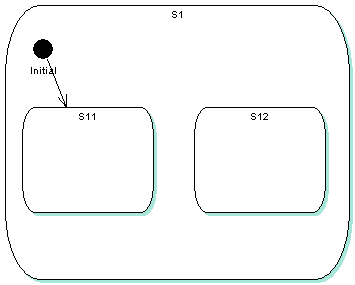
SCXML Equivalent
<?xml version="1.0" encoding="us-ascii"?>
<scxml version="1.0" xmlns="http://www.w3.org/2005/07/scxml">
<state id="S1">
<state id="S11">
</state>
<state id="s12">
</state>
<initial>
<transition>
<target next="S11"/>
</transition>
</initial>
</state>
</scxml>
In this particular case, S1 has sequential substates.
When a state machine is in a state with such substates, it must
also be in one and only one of the substates. The substates have a
kind of "Or" semantics and can be thought of as representing a
decomposition of the parent state. A transition moving the system
to S1 may specify S11 or S12 as its target directly.
However, to handle the case where it doesn't, S1 contains an
initial element defining the default substate that it
will start in if the transition simplify specifies S1 as its
destination. In Diagram 3, the default substate is S11.
E.4 Parallel States
In addition to sequential substates, Harel State Charts provide
concurrent substates, which represent a form of "And"
logic. When a state machine is in a state with concurrent substates
it must be simultaneously in each of the concurrent child
states. The concurrent child states operate independently until
they all terminate (normally by reaching terminal child states) at
which point the parent state also terminates. Concurrent substates
thus represent fork and join logic. They are represented in our
notation by the parallel tag. Diagram 4 below
represents an elaboration of Diagram 3. First of all, State S11 has
been decomposed into further sequential substates, S111 and S112,
with S111 being the default initial state. Secondly, concurrent
substates S121, S122, and S123 have been added to State S12.
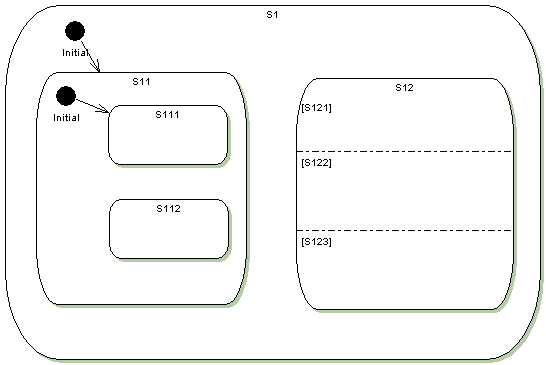
SCXML Equivalent
<?xml version="1.0" encoding="us-ascii"?>
<scxml version="1.0" xmlns="http://www.w3.org/2005/07/scxml">
<state id="S1">
<state id="S11">
<state id="S111"/>
<state id="S112"/>
<initial>
<transition>
<target next="S111"/>
</transition>
</initial>
</state>
<state id="s12">
<parallel>
<state id="S121"/>
<state id="S122"/>
<state id="S123"/>
</parallel>
</state>
<initial>
<transition>
<target next="S11"/>
</transition>
</initial>
</state>
<state>
</state>
</scxml>
As Diagram 4 shows, the notion of complex state is fully
recursive, so that the child states of a complex parent may
themselves have sequential or concurrent children. Thus a complex
state machine is not normally in a single state, but in a
configuration of compatible states. Applying the rules for
sequential and concurrent states recursively in Diagram 4, we see
that when the machine is in S1 it must also be in S11 or S12. When
the machine is in S11, it must be in S111 or S112. When the machine
is in S12, on the other hand, it must simultaneously be in all
three substates S121, S11 and S1123. Thus there are 3 legal
configurations they machine can be in: S1 plus S11 plus S111, S1
plus S11 plus S112, and S1 plus S12 plus S121, S122, and S123.
E.5 Concurrency And
Event Queues
The Harel semantics for transitions is based on the notion of an
underlying event queue. At any given point, the state machine is in
a specific configuration of states. If there is an event in the
queue, it is processed according to the given state configuration,
and a transition may be triggered. The transition is then taken and
it and all actions associated with it are executed before the next
event in the queue is examined. Of particular interest is the way
that onexit and onevent handlers interact
with transitions. Suppose the machine is in state S2 (which is not
shown in the diagram) and an event occurs which triggers a
transition to state S112 in Diagram 4. In this case, the machine
first leaves S2, executing S2's onexithandlers. It
then executes any actions in the selected transitions.
Then it enters S1, S11, and S112 executing their
onentry handlers in that order. Only when all these
actions have been executed will the machine check its queue for
another event. Suppose that there is an event in the queue and it
triggers a transition from S112 to S12. Going to S12 entails
leaving both S112 and S11, so both their onexit
handlers fire in that order, before the actions in the
transition. (Note that the onexit handlers fire in the
reverse order of the onentry handlers.) Since S11 and
S12 are both substates of S1, this transition does not entail
leaving S1 so its onexit handler does not fire. After
the transition's actions, S12's onentry
handler will fire. Furthermore, the semantics of parallel states
requires that entering S12 also involves entering each of its
concurrent substates simultaneously. Therefore the
onentry handlers for S121, S122, and S123 will all
fire after the one for S12. Since entry into the parallel substates
is simultaneous, however, there is no guarantee on the order in
which the three substate handlers fire.
Complex state configurations also interact with the selection of
the transition to execute. First off, note that even a simple state
may contain multiple transitions that match a given event. For
example State S1 may contain two transitions, T1 which is triggered
by event E1 with guard Cond1, and T2 which is also triggered by E1,
but with a different guard expression Cond2. If the machine is in
S2 when event E1 is taken from the queue and processed, it is
possible that both Cond1 and Cond2 will evaluate to true. In this
case, we will say that both T1 and T2 are enabled, but
only one of them can be selected and executed. In the case of a
single state, we will use document order as the tie-breaker,
choosing whichever transition occurs first in the definition of S1.
With complex states, the issue is more difficult. Returning to
Diagram 4, suppose that we are in the complex configuration S1,
S11, and S112, when event E1 is processed. It is possible that all
three states, S1, S11, and S112, contain transitions that are
enabled. In this case, we start in the innermost state S112. If it
has an enabled transition, we select it (using document order as a
tie-breaker if it has more than one.) If S112 does not contain an
enabled transition, we look in S11 and then in S1. Thus the most
narrowly scoped transition wins. The motivation for this choice
becomes clear when we remember that sequential substates are
decompositions of the parent state. Thus S112 is a refinement of
S11 and S11 in turn is a refinement of S1. The innermost state thus
"knows the most" about the situation so its transitions are
preferred to those in outer states, which can be treated as
defaults or fallbacks.
In the case of concurrent substates, the event is processed by
all concurrent states simultaneously and they select their
transitions independently. Thus if we are in S1, S12 and parallel
substates S121, S122, and S123, any event will be processed by
S121, S122, and S123 simultaneously, and they may all select
transitions. This makes most sense if all three states are
themselves complex and the event is triggering transitions among
their substates. If none of the three states handles the event, we
move to S12 and then to S1.
Although parallel substates run independently their operations
can be coordinated by means of Join and Synch states. The Join
pseudo-state is has multiple incoming transitions and one or more
outgoing transition. The incoming transitions must be unconditional
(i.e., they cannot have cond or event
properties.) The outgoing transitions on the join may
not have event triggers and at least one must lack a
cond guard condition. Thus when the join
pseudo-state is finally entered, there is always a transition that
can be taken immediately. The join pseudo-state is not
entered until all its incoming transitions are enabled.
Thus the various threads of control wait in their current states
until they are all ready to enter the join, at which
point they all enter simultaneously and an outgoing transition is
selected.
Now suppose we have two parallel states, S1 and S2, with
sequential substates S11, S12, S13 and S21, S22 and S23, as shown
in Diagram 5.
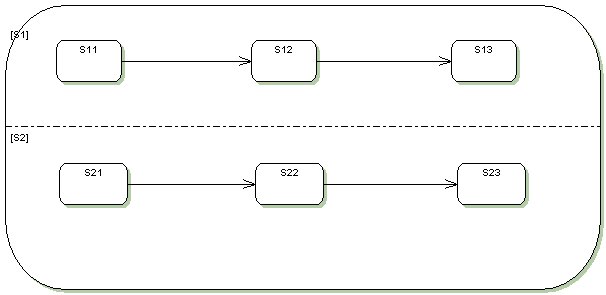
SCXML Equivalent
<?xml version="1.0" encoding="us-ascii"?>
<scxml version="1.0" xmlns="http://www.w3.org/2005/07/scxml">
<state>
<parallel>
<state id="S1">
<state id="S11">
<transition>
<target next ="S12"/>
</transition>
</state>
<state id="S12">
<transition>
<target next="S13"/>
</transition>
</state>
<state id="S13"/>
</state>
<state id="S2">
<state id="S21">
<transition>
<target next ="S22"/>
</transition>
</state>
<state id="S22">
<transition>
<target next="S23"/>
</transition>
</state>
<state id="S23"/>
</state>
</parallel>
</state>
</scxml>
E.6 Synchronizing And
Concurrency
Given the basic Harel semantics S1 and S2 will function
independently, so that S1 will move from S11 to S12 to S13 without
regard to what S2 is doing, and vice-versa. But now suppose that we
want to ensure that S2 does not transition from S22 to S23 until S1
has left S11. Diagram 6 shows how we can do this using
join and syncstates.
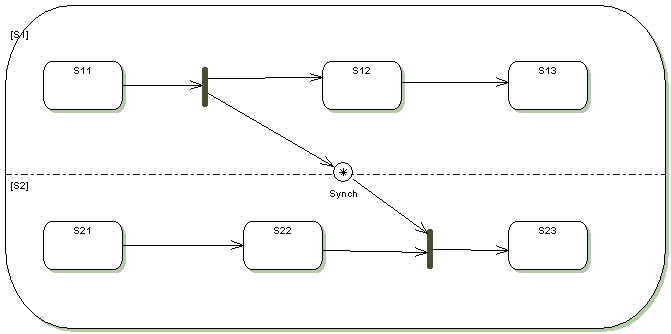
SCXML Equivalent
<?xml version="1.0" encoding="us-ascii"?>
<scxml version="1.0" xmlns="http://www.w3.org/2005/07/scxml">
<state>
<parallel>
<state id="S1">
<state id="S11">
<transition>
<target next ="S12"/>
<target next="synch1"/>
</transition>
</state>
<state id="S12">
<transition>
<target next="S13"/>
</transition>
</state>
<state id="S13"/>
</state>
<state id="S2">
<state id="S21">
<transition>
<target next ="S12"/>
</transition>
</state>
<state id="S22">
<transition>
<target next="j1"/>
</transition>
</state>
<state id="S23"/>
</state>
<sync id="synch1">
<transition>
<target next="j1"/>
</transition>
</sync>
<join id="j1">
<transition>
<target next="S23"/>
</transition>
</join>
</parallel>
</state>
</scxml>
We have inserted a join pseudo-state between S22
and S23, with a conditionless incoming transition from S22 and a
conditionless outgoing transition to S23. (The join
pseudo-state is represented as a vertical bar with multiple
incoming transitions and a single outgoing transition.) We also
added a sync state with a conditionless outgoing
transition to the same join. Then we took all the
transitions that leave S11 and have them branch to include the
sync state as an extra target. (In the diagram this is
shown by inserting a 'fork' vertical bar, with a single incoming
transition and multiple outgoing transitions. In our SCXML
notation, we would use multiple values in the target
element). Now when the machine reaches S22, it will wait until the
sync state is active (and therefore ready to
transition) before entering the join and transitioning
to S23. When S1 is ready to leave S11, it in effect branches
control, with its normal execution continuing along one branch of
the transition while the other branch enters the
sync state, which triggers the join and
allows S2 to proceed. Note that S1 may reach the sync
state before or after S2 reaches S22. In either case, the combined
effect of the sync state and the join is
to allow S1's processing to continue as before, while ensuring that
S2 will wait in S22, if necessary, for the signal that S1 has left
S11.
E.7 Sync Explained
The sync state is really serving as a buffer to
keep the effect of the join from propagating back into
S1. For example, it would be possible to omit the sync
state and connect S11's branching transition directly to the
join. However, in that case, if S1 was ready to leave
S11 before S2 reached S22, by the semantics of the
join, S1 would have to block in S11 waiting for S2.
This is not the behavior we want because the purpose of the
synchronization is to control the behavior of S2 without changing
the flow of S1. If we want to synchronize multiple regions, so that
both S2 and S3 would wait until S1 left S11, we can use multiple
sync states, one for S2 and one for S3, and have the
transition from S11 branch to both of them.
The sync state uses an internal counter to keep
track of how often it has been entered and exited, augmenting the
counter when it is entered and decrementing it when it is exited.
The sync state will take its outgoing transition only
when the counter is positive. The bound value puts a
limit on how large a value the counter can hold. For example,
setting bound to 1 turns the state into a binary
semaphore, that can be exited only once no matter how often it has
been entered. The default value for bound is
unlimited.
For an example of the use of a higher bound, consider states S1
and S2 as before, but now suppose that we want to restrict S2 to
wait in S21 until S1 exits S11 and to wait in S22 until S1 exits
S12. We could use two separate syncsteps for this, but
one will suffice, as Diagram 7 shows.
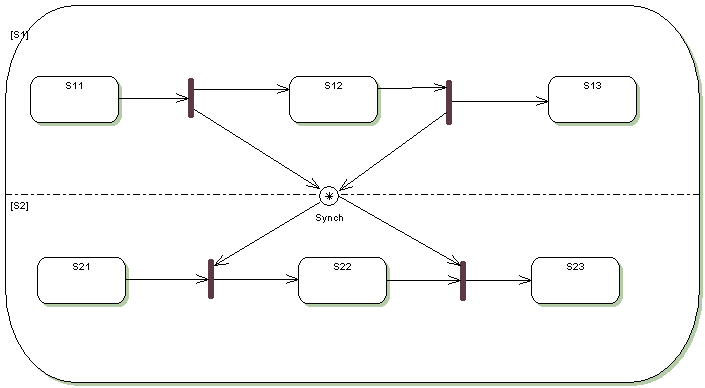
SCXML Equivalent
<?xml version="1.0" encoding="us-ascii"?>
<scxml version="1.0" xmlns="http://www.w3.org/2005/07/scxml">
<state>
<parallel>
<state id="S1">
<state id="S11">
<transition>
<target next ="S12"/>
<target next="synch1"/>
</transition>
</state>
<state id="S12">
<transition>
<target next="S13"/>
<target next="synch1"/>
</transition>
</state>
<state id="S13"/>
</state>
<state id="S2">
<state id="S21">
<transition>
<target next ="S12"/>
</transition>
</state>
<state id="S22">
<transition>
<target next="j1"/>
</transition>
</state>
<state id="S23"/>
</state>
<sync id="synch1">
<transition>
<target next="j1"/>
</transition>
<transition>
<target next="j2"/>
</transition>
</sync>
<join id="j1">
<transition>
<target next="S23"/>
</transition>
</join>
<join id="j2">
<transition>
<target next="S23"/>
</transition>
</join>
</parallel>
</state>
</scxml>
Here we have branching transitions from S11 and S12, and two
outgoing transitions, one to a join between S21 and
S22, and another to a join between S22 and S23.
Suppose S1 races ahead of S2, moving from S11 to S12 to S13. The
sync state will have been entered twice, so its
counter will be 2. When S2 is ready to leave S21, the
syncstate will be ready and take the transition to the
join, decrementing its counter to 1. When S2 is ready to leave S2,
the fact that the counter is still positive means that the
sync state will still be active and ready to take the
transition to the join.
E.8 Microwave
Oven
This example implements a simple microwave oven that can be in
one of two states:
On --- the oven is running
Off --- the oven is turned off
State
on itself has two substates:
Cooking --- the oven is cooking
Idle --- the oven is idle
The oven responds to three external event sources:
Door open/close
Timer that tracks cook-time
Power button
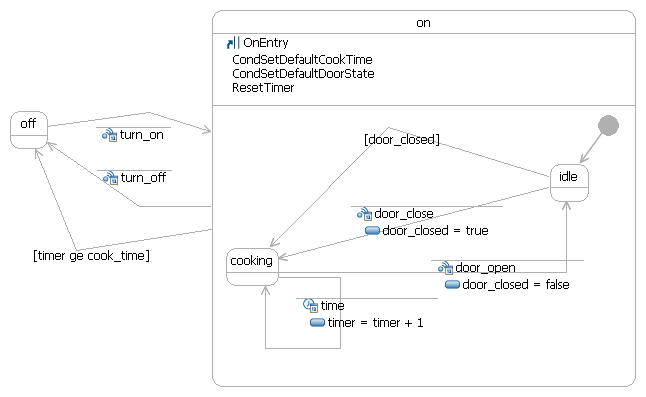
SCXML Equivalent:
<?xml version="1.0"?>
<scxml xmlns="http://www.w3.org/2005/07/scxml"
version="1.0"
initialstate="off">
<!-- trivial microwave oven example -->
<state id="off">
<!-- off state -->
<transition event="turn_on">
<target next="on"/>
</transition>
</state>
<state id="on">
<initial>
<transition>
<target next="idle"/>
</transition>
</initial>
<!-- on/pause state -->
<onentry>
<!-- we assume the cook_time is passed in as a context parameter -->
<if cond="${empty cook_time}">
<!-- default setting -->
<var name="cook_time" expr="${5}"/>
</if>
<!-- again, door_closed should be a part of a global context -->
<if cond="${empty door_closed}">
<!-- default setting -->
<var name="door_closed" expr="${true}"/>
</if>
<!-- timer variable -->
<var name="timer" expr="${0}"/>
</onentry>
<transition event="turn_off">
<target next="off"/>
</transition>
<transition cond="${timer ge cook_time}">
<target next="off"/>
</transition>
<state id="idle">
<transition cond="${door_closed}">
<!-- default immediate transition -->
<target next="cooking"/>
</transition>
<transition event="door_close">
<assign name="door_closed" expr="${true}"/>
<!-- start cooking -->
<target next="cooking"/>
</transition>
</state>
<state id="cooking">
<transition event="door_open">
<assign name="door_closed" expr="${false}"/>
<target next="idle"/>
</transition>
<transition event="time">
<assign name="timer" expr="${timer + 1}"/>
<target next="cooking"/>
</transition>
</state>
</state>
</scxml>
Next, we show the same microwave example, but this time
implemented using parallel.
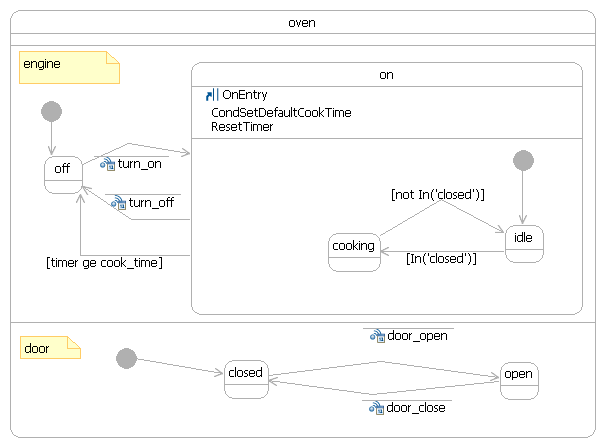
SCXML Equivalent:
<?xml version="1.0"?>
<scxml xmlns="http://www.w3.org/2005/07/scxml" version="1.0"
initialstate="oven">
<!-- trivial microwave oven example -->
<!-- using parallel and In() predicate -->
<state id="oven">
<parallel id="parts">
<state id="engine">
<transition>
<target next="off"/>
</transition>
<state id="off">
<!-- off state -->
<transition event="turn_on">
<target next="on"/>
</transition>
</state>
<state id="on">
<transition>
<target next="idle"/>
</transition>
<!-- on/pause state -->
<onentry>
<!-- we assume the cook_time is passed in as a context parameter -->
<if cond="${empty cook_time}">
<!-- default setting -->
<var name="cook_time" expr="${5}"/>
</if>
<!-- timer variable -->
<var name="timer" expr="${0}"/>
</onentry>
<transition event="turn_off">
<target next="off"/>
</transition>
<transition cond="${timer ge cook_time}">
<target next="off"/>
</transition>
<state id="idle">
<transition cond="${In('closed')}">
<target next="cooking"/>
</transition>
</state>
<state id="cooking">
<transition cond="${not In('closed')}">
<target next="idle"/>
</transition>
<transition event="time">
<assign name="timer" expr="${timer + 1}"/>
<target next="cooking"/>
</transition>
</state>
</state>
</state>
<state id="door">
<initial>
<transition>
<target next="closed"/>
</transition>
</initial>
<state id="closed">
<transition event="door_open">
<target next="open"/>
</transition>
</state>
<state id="open">
<transition event="door_close">
<target next="closed"/>
</transition>
</state>
</state>
</parallel>
</state>
</scxml>








